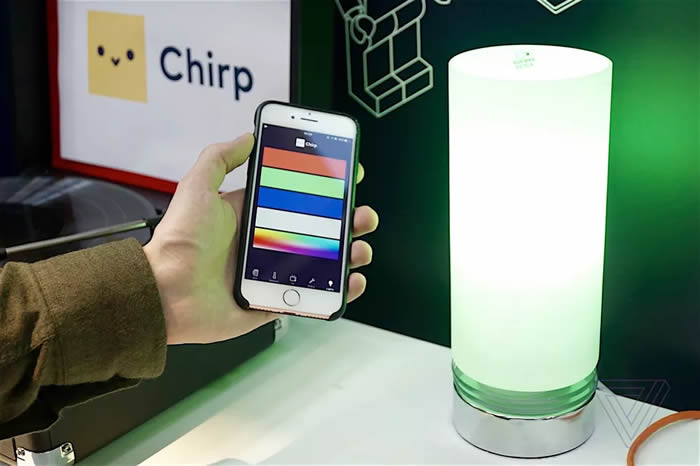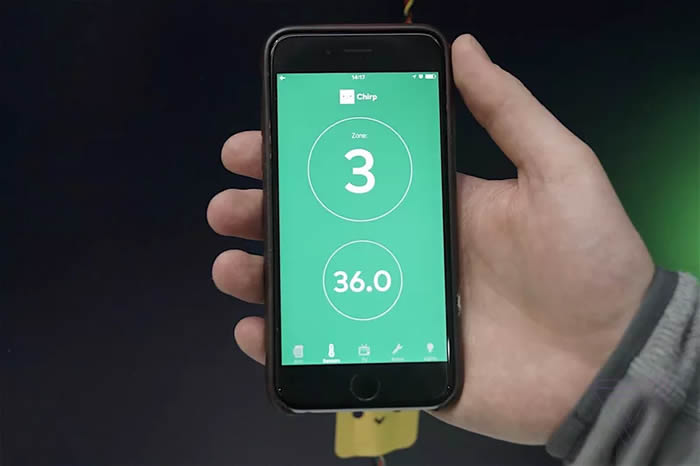Machine-To-Machine Data Transfer In Bird Song
In The Peripheral, William Gibson’s most recent novel, there’s a pair of bodyguards who talk to one another using what sounds like birdsong. Everything they say is translated into this encrypted medium, and only they can decrypt it, giving them a secure way of communicating. It’s a typical Gibsonian device: imaginative, elegant, but also closer to technological reality than you might think.
Chirp isn’t making encrypted comms channels for sci-fi bodyguards, of course. What it is doing, though, is exploring how short bursts of encoded sound (that do actually sound like robotic birdsong — hence the company’s name) can transfer data from machine to machine. The company started life as a research project at University College London, and back in 2012 launched a file-sharing app for smartphone users. It failed, but the firm has reinvented itself as a business-to-business firm, selling its tech to a range of clients from Activision (for the video game Skylanders) to Shuttl (an Indian bus-booking app).
It’s an engaging idea, sending data via audio, but using sound to do the job of Bluetooth or NFC comes with a unique set of pros and cons.
Pro: it works with any electronic device that has a microphone and speaker. Con: it can’t send a signal further than hearing range (although just as with hearing, you can send information greater distances by being louder). Pro: it doesn’t need an active network or internet connection, making it perfect as a failsafe communication system or for secure, air-gapped devices. Con: the amount of data it can transfer is tiny. In a standard burst, the Chirp protocol transfers just 50 to 100 bits per second — acting like a sort of audio QR code directing a phone or computer to a webpage. But, as Jones explains, the protocol can be tweaked — either to send more information, or to set up a continuous flow of data.
“You have this triangle of constraints,” he says. “The data rate, the robustness, and the aesthetics, and they’re all pushing against one another. If you want it to sound nice, your data rate will be a little bit lower. But if you want it to be robust and high bandwidth, it won’t sound as nice.” He explains that the tech isn’t limited to audible sound either — it works just as well in the inaudible ultrasound range, even using the standard microphones and speakers found in most consumer electronics.
As a consumer product Chirp never took off, but its unique set of affordances shape how it’s used, and make it particularly suitable in certain situations. With the Indian bus service Shuttl, for example, using audio for contactless ticketing means the app can be used even by customers who don’t have NFC or Bluetooth-enabled phones.
Chirp is also testing its technology for what’s known as the industrial internet of things — i.e., factories full of connected robots and sensors. Using audio for data can be particularly useful in this sector, says Jones, as it works with legacy technology, and can take advantage of existing infrastructure like PA systems to communicate with multiple devices at once. (Imagine a factory full of autonomous bots that snap to attention simultaneously as a robotic whistle plays overhead.)
“That’s what we’ve been doing as a prototype for a partner in the energy industry,” says Jones. “They’re keen to create a wireless link between a sensor that is continually reading information and a remote data logger.” He adds that implementations like this are also well-suited in scenarios where radio frequency communication is restricted — like nuclear or medical sites.
Jones makes it easy to believe in data-over-audio as a sturdy proto-network that will be still standing after some unforeseen emergency wipes out other channels. “Audio is arguably the oldest communication medium in existence,” he says. “From speech to Morse code to radio telephony to dial up modems. And that is, in part, its strength: it’s simple, ubiquitous, and low tech. Like the last point of failure when all of the wider network has gone down.”
This is true, but just because something is useful in an emergency, doesn’t mean it’s useful all the time. Chirp understands the limitations of its technology (range and bandwidth being the biggest stumbling blocks), and admits that it’s never going to be useful in every scenario. But the company is designing a range of SDKs that make it easier to plug the tech into devices of every shape and size, and Jones is confident there’s enough niches in the world to make Chirp a success.
“Sound bridges a lot of heterogenous gaps in the world of connectivity,” he says. “In broadcast you can use an audio stream as a carrier of data; in gaming it can be a link between console and tablet; in industry it can be used in places where electromagnetic waves are regulated.”
More information: The Verge




